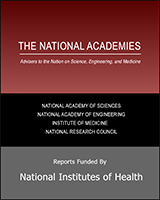NCBI Bookshelf. A service of the National Library of Medicine, National Institutes of Health.
Institute of Medicine (US) Board on Population Health and Public Health Practice. Sex-Specific Reporting of Scientific Research: A Workshop Summary. Washington (DC): National Academies Press (US); 2012.

Sex-Specific Reporting of Scientific Research: A Workshop Summary.
Show detailsThe number of women participating in clinical trials has increased over the last two decades, but women are still underrepresented in clinical trials in general. Some of the overall increase can be attributed to the greater number of women-only trials (of therapies for diseases that affect only women). Even when women are included in clinical trials, the results are often not analyzed separately by sex.
On August 30, 2011, the Institute of Medicine (IOM) Board on Population Health and Public Health Practice hosted the workshop Sex-Specific Reporting of Scientific Research. Nancy Adler, professor of medical psychology at the University of California, San Francisco, and workshop chair, cited a recent review of high-impact publications of clinical studies, including clinical trials and prospective cohort studies, of non–sex-specific cancers. It found that women constituted less than 40% of participants (Jagsi et al., 2009). Other research indicates that studies of cardiovascular disease are particularly male-biased. A review of 19 randomized controlled cardiovascular trials found that only 27% of the participants were female and that only 13 of the studies presented sex-based analyses of the data (Kim and Menon, 2009). That bias is often unintentional, Adler noted. In designing inclusion criteria, for example, early age of onset of myocardial infarction and chest pain as a presenting symptom will favor the enrollment of men over women (Bairey Merz et al., 2006; Canto et al., 2007; Gurwitz et al., 1992). Similarly, the end points selected can lead to bias. Unstable angina, stroke, and unrecognized myocardial infarction are more common in women, and if a study does not include these as end points, cardiovascular disease in female participants may be underestimated. Bias in inclusion criteria in human immunodeficiency virus (HIV) studies has also been reported (Gandhi et al., 2005). In addition, there is a substantial male bias in animal models of disease, even for diseases that are more prevalent in women.
A recent IOM consensus report, Women’s Health Research: Progress, Pitfalls, and Promise (IOM, 2010, p. 12), found that
limitations in the design, analysis, and scientific reporting of health research have slowed progress in women’s health. Inadequate enforcement of recruitment of women and of reporting data by sex has fostered suboptimal analysis and reporting of data on women from clinical trials and other research. That failure has limited possibilities for identifying potentially important sex or gender differences. New methods and approaches are needed to maximize advances in promoting women’s health.
On the basis of that finding, the IOM committee recommended (IOM, 2010, p. 13) that
the International Committee of Medical Journal Editors and other editors of relevant journals should adopt a guideline that all papers reporting the outcomes of clinical trials report on men and women separately unless a trial is of a sex-specific condition. . . . The National Institutes of Health should sponsor a meeting to facilitate the establishment of the guidelines.
To address the recommendation, the NIH ORWH requested that the IOM convene a 1-day workshop to explore the benefits of and barriers to sex-specific reporting of scientific data. The workshop brought together representatives of academe, industry, government, and research-advocacy organizations and editors of leading scientific and medical journals to consider
- the need for sex-specific reporting of scientific results;
- potential barriers to and unintended consequences of sex-specific reporting of scientific results;
- experiences of journals that have implemented sex-specific requirements, including the challenges and benefits of such editorial policies; and
- steps to facilitate the reporting of sex-specific results.
The present report summarizes the presentations and discussions by the expert panelists. The first session focused on why sex-specific reporting is important. Panelists highlighted historical and current events that have hindered or helped to advance the study of women. In the next session, panelists in academe discussed the challenges of collecting, analyzing, and reporting sex-specific data from the researcher’s perspective. That was followed by two panels of leading journal editors who shared their experiences in developing and implementing editorial policies and the implications of sex-specific reporting policies for journals. In the final session, members of the workshop planning committee and others reflected on the discussion and summarized the individual suggestions made over the course of the day for advancing sex-specific reporting of scientific research.
- INTRODUCTION - Sex-Specific Reporting of Scientific ResearchINTRODUCTION - Sex-Specific Reporting of Scientific Research
Your browsing activity is empty.
Activity recording is turned off.
See more...